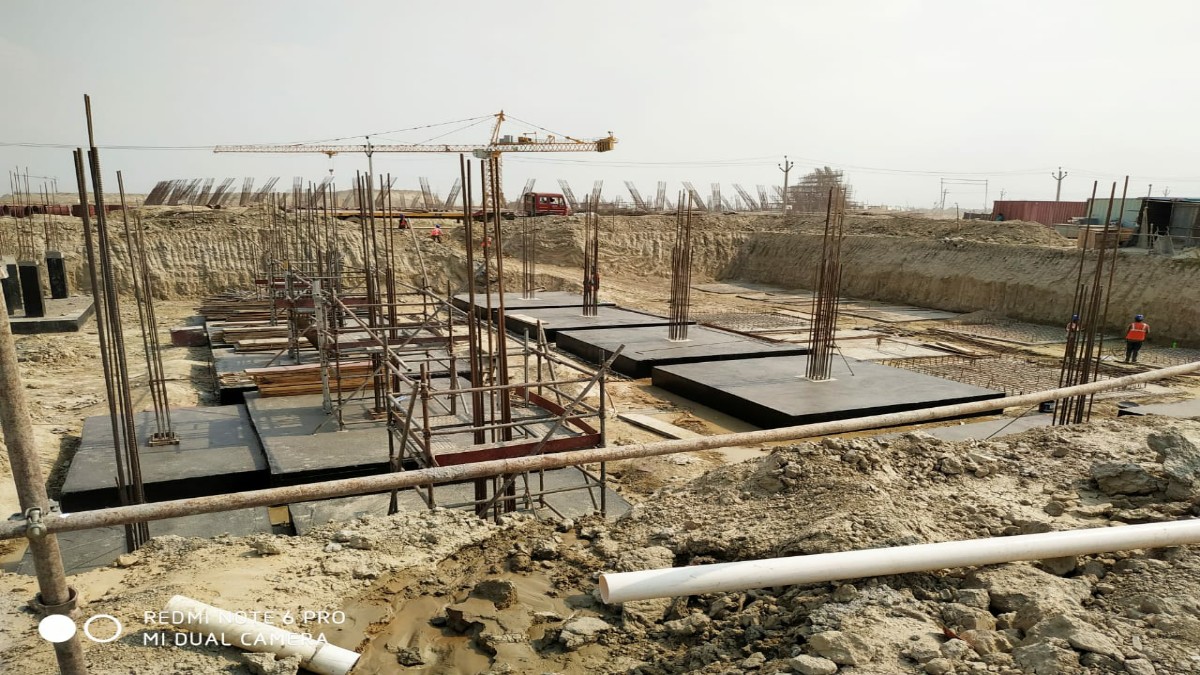Raft foundation is a continuous slab that completely covers the entire site of the proposed structure and rests on the soil. Depending on the applications and design loads, there are various raft foundation types. The choice of raft foundation type is influenced by a number of variables, including bearing capacity, loads, site circumstances, etc.
Raft foundation – Definition
A raft foundation or mat foundation is a solid slab that is put at a predetermined depth and covers the entire structure. Raft foundations have shear walls and columns for distributing loads to the ground. These foundations are appropriate for places with low bearing capacity, wherein individual footings struggle to traverse the stresses. Moreover, the raft foundation aids in the transfer of the structure’s total load to a larger area. In comparison to other forms of foundations used in civil construction, raft foundations can minimize soil stress levels. This mechanism of stress distribution distinguishes raft foundations from other types of foundations.
Determining soil stress
Stress = total load acting on the structure + raft self weight / raft foundation area
Assume a total load of 300 T and a foundation size of 20 m x 10 m
Soil stress = 300/200 = 1.5 t/sqm
The same structure is supported by 8 separate footings. 2 x 2 mtr 8 x 4 = 32 sqm total space
Soil stress = 300/32 = 9.375 t/sqm
This demonstrates that for the same weight, we get stresses of 1.5 T/sqm for the raft and 9.375 T/sqm for the individual foundations.
Because the raft’s contact area is greater, the load is distributed across a larger region, resulting in less stress on the soil.
Raft foundations – Where to use them?
When the following circumstances exist, these foundations are typically favoured over other foundation types.
- When the bearing capacity of the soil is extremely low, building individual footings and executing deep foundations such as pile foundations becomes prohibitively expensive.
- When soil stresses must be reduced since the soil’s bearing capacity is lower.
- The columns, shear walls, and so on are so close to each other that individual footings may overlap.
- Any other type of foundation may cover more than 50% of the total ground area beneath the structure.
- When there is a possibility of unequal settlement.
- Likewise, Raft foundations are Preferred for complex equipment foundations.
- When the proposed structure has basements, raft foundations are preferred
For basement constructions where the foundation slabs would be subjected to direct live loads raft foundations are preferred based on the utility of the structure. Raft foundations are also a preferable option for sites where soil conditions are poor and access to major excavation machinery is limited, wherein raft foundations excavations can be accomplished with the help of light excavators.
Types of raft foundations
Raft foundations are classified into several types based on soil conditions, structure functionality, and so on. The following are some of the most popular raft foundation types used in civil construction.
- Solid Slab Raft foundation/ Flat plate type foundations
- Slab beam Raft foundation
- Piled Raft Foundation
- Cellular raft foundation
- Balancing or floating raft foundation
Solid Slab Raft Foundations
Flat plate raft foundations are made up of a reinforced concrete slab of uniform thickness covering the entire bearing area. In this type of raft foundation, the columns and walls are equally spaced, and the load distribution is also equal.
These raft foundations are known as solid slab raft foundations because they are designed as slabs with uniform thickness. This is ideal when the columns are evenly spaced and have equal and minor weights. Steel mesh reinforcement is offered in both directions of the slab. Two meshes are reinforced at the top and bottom of the slab to balance upward and downward bending stresses.
The following are the various types of solid slab raft foundations that are commonly used based on design requirements.
- Thickened flat plate type raft foundation
- Wide toe raft foundations
- Blanket rafts
- Slip plane raft foundations
Thickened flat plate type raft foundations
When the column loads are extremely heavy, the flat plate type foundation is inadequate. To make it suitable, the slab thickness must be increased. The substantial loads on the column cause negative bending moments and diagonal shear in the slab. A full-size solid slab mat base is not required to negotiate the design loads. To compensate, a section of the slab beneath the column should be thickened. The placement of a pedestal beneath the column without increasing the slab thickness also assists in receiving heavy loads.
Wide toe raft foundations
A wide toe raft is used when the ground conditions require an unusually thick concrete slab to provide the necessary load support, which would be quite expensive. For negotiating the design loads, a full-size solid slab mat base is not necessary. A substantially reinforced toe is provided on both sides of the structure, as illustrated in the image, for economizing the structure.
Blanket raft foundations
When the construction site comprises small areas of weaker soil or diverse soil types with unequal settlements or nonuniform strata, a blanket raft may be the best option. Before laying the raft foundation, the surface is compacted and stone blankets are spread in layers on the prepared ground, as shown in the figure. However, despite the build’s footprint’s flaws, the raft foundation and stone blanket work together to provide even load support.
Slip plane raft foundations
A preliminary layer of sand is put across a slightly larger surface than the required raft foundation for slip plane rafts, and the gap around the raft is filled with packed material. A thoroughly compacted sand bed supports this type of foundation beneath the raft. The foundation’s sides can be filled with any compressible material.
Slab beam type raft foundations
When the loads are unequally distributed, there seems to be a lot of space between the columns, and the foundation is susceptible to distortions, slab beam raft foundations are preferred. Beams are set in perpendicular directions in this scenario, and they are all connected by a raft slab. The beams incorporated with the slab act as stiffeners and prevent distortions. Columns are precisely located on the intersections of raft foundation beams, as illustrated in the figure. The raft’s reinforcement consists of two mesh layers, one at the bottom and one at the top.
Piled raft foundation
Pile foundations are used to support the slab in the case of piled raft foundations. When the loads on the structure are exceedingly high, the soil bearing capacity is very low, and the water table is exceptionally high, this method is commonly used. Piled raft foundations are ideal for high-rise buildings and large industrial structures such as high-rise RCC chimneys, silos, and storage tanks that are typically supported by a single foundation element. Because of their exorbitant costs, these foundations are not generally used in residential applications. Designing a very heavy raft foundation or a very conservative pile foundation with greater depths is avoided by using a piled raft. Instead, they opt for a hybrid of an optimal raft foundation and a pile foundation capable of supporting the structural loads.
Cellular raft foundation
A cellular raft is made up of two-way foundation beams with a solid slab lying on the ground below and a suspended slab on top. Between the upper and lower slabs, intermediate beams are provided. The intermediate beam is responsible for transforming the entire structure into an I Beam. The top slab is cast using precast soffits or various types of permanent formwork, sacrificial formwork, or lightweight infill blocks. Cellular raft foundations are often used in areas with significant mining activity and poor soil carrying capacity, where the foundations must withstand huge bending moments. These types of raft foundations are used when eliminating overburdens resulting in greater bearing capacity. Moreover, cellular rafts can be used to control soil uplift pressure.
Balancing raft or Floating Raft Foundation
Balancing rafts or floating foundations are deployed in situations where the soil bearing capacity is very low and the soil settlements must be kept within an acceptable range.
The floating foundation operates on the idea that the total weight of the earth and water removed from the excavated area must equal the weight of the planned structure.
This process involves huge earthwork excavation. Dewatering systems like well point systems have to be provided when the water table is very high. Likewise, Sheet piles are to be installed for weak soils or soils that may collapse. To protect the nearby structures from any defects due to scoring of soil, temporary retaining walls etc. have to be organized before starting excavation and some of these activities have to go in tandem with excavation. This type of structure is not economical and requires very minute technical supervision.
These foundation types are used for building structures in highly dense areas following all safety precautions to avoid any damage to the nearby structures.
Floating rafts are preferred for building with multiple levels of underground car parking facilities. However, for more details about floating rafts, you can go through our detailed article Balancing rafts or floating raft foundations
Advantages of Raft Foundations
- Raft foundations offer a safe and cost-effective alternative to conventional shallow and deep foundation types.
- Preferable in areas with low soil bearing capacity, uneven settlement, and the presence of mixed soil types. By distributing stresses across a larger area, these foundations are able to achieve load-bearing capacity.
- Used in congested metropolitan locations where access to sites is limited and heavy machinery mobilisation for foundation construction using conventional deep foundations, such as pile foundations, is not feasible.
- Raft foundations can be built using very light machinery due to their low heights.
- Raft foundations offer designers a much-needed alternative to conventional isolated foundations for limiting the settlement restrictions within the codal provisions.
- When compared to regular foundations, the designers have the option of choosing larger settlement values during the design process in the case of raft foundations. Moreover this in turn can avoid an unequal settlement.
- Got flexible design alternatives that can be customized as per soil conditions and workability.
- Comparatively speaking, the execution is simpler than individual footings. This, in turn, can accelerate the project schedule.
Disadvantages of raft foundations
- In extremely poor soil conditions, raft foundations are not cost-effective.
- Complex raft foundations demand careful professional/technical supervision and workmanship and consume a substantial amount of concrete, and steel. As a result, the structure is more expensive than any other alternative foundation.
- The soil beneath the foundation, particularly around the margins, must be protected. Edge erosion is common in raft foundations.
- When the soil conditions are extremely poor, pile foundations are more cost-effective than raft foundations.
- Raft foundations occasionally need further strengthening, which raises the overall cost.
- Compared to other foundations, skilled labour is needed for raft foundations.
- When the mat or raft foundation is under the concentrated(point) load, further care should be taken.


















